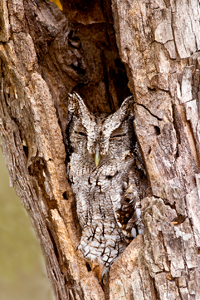
Owls are unusual and secretive birds. Most are active at night, so finding an owl is always an exciting event – and often requires some patience and skill. The best ways to find an owl are to go outside and wait to hear their calls at night then follow the calls; or during the day look for traces of where owls roost or feed by looking for whitewash, pellets under a tree, or the easiest – listen and watch for mobbing behavior by smaller birds. The object of their angst may well be an owl.
Owls like to remain in the same area and some return to the same tree. So once you find where they are, you may find them for days at a time snoozing in the open. They are most active and vocal making them easier to find when they are mating from November through winter. As birdwatchers, we owe it to the birds to keep our distance and not disturb them.
Keeping our owls safe requires a little more thought than with many other birds. And, there are some things to avoid which are not in the owl’s best interest and may cause undue stress or injury.
- Playing Owl Calls: While playing owl calls may elicit a response to your recorded call, and lets you know which birds are in the area, it also lets other owls in the area know where their competitors are. Smaller owls are made vulnerable to predation by their larger cousins if they reveal their location unnecessarily
- Social Media: Owls really need their privacy, and using social media to report their locations may cause them to be harassed and stressed. It may also cause the owl to need to find another location. This is a topic that continues to be debated, but widespread reporting of an owl that has chosen to not be in a public place is likely not going to be safe for the owl.
- Getting Close: As with most birds, keeping a distance that doesn’t stress the bird also keeps the bird in view for longer looks. Every bird has their own sense of how close they can tolerate people before they are disturbed. But, if the owl sees you and starts to change position or fly off, you are too close.
- Baiting Owls: Some photographers set live or dead bait out for owls to get the shot they want. But there are a multitude of reasons why this can be harmful to the birds. One major problem with baiting is that it can quickly habituate the birds to humans and cause them to frequent areas like busy roads where there is a great risk of colliding with vehicles. Scott Weidensaul, who is a well-known owl researcher and co-founder of Project Snowstorm which studies Snowy Owls, talks about baiting in this Audubon article.
Owling is a great way to hone your birding skills and spend a winter’s evening with friends and family. Who knows what you will hear or see? But there is nothing as magical as hearing a wild owl hooting in a cold, still, winter’s night.